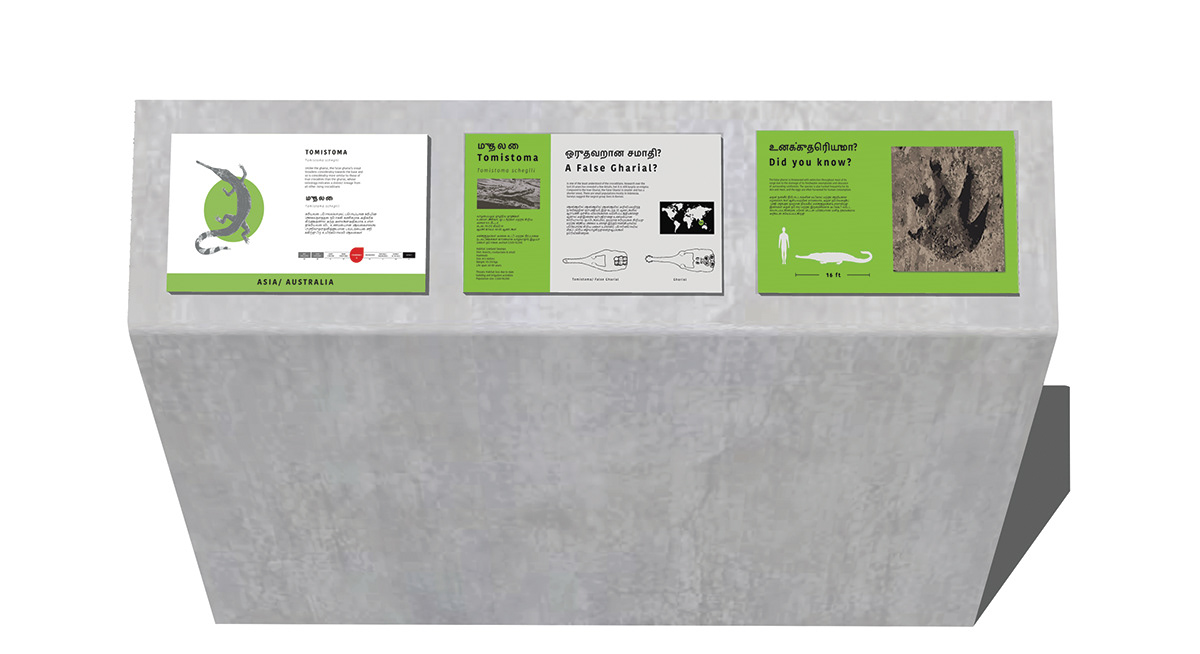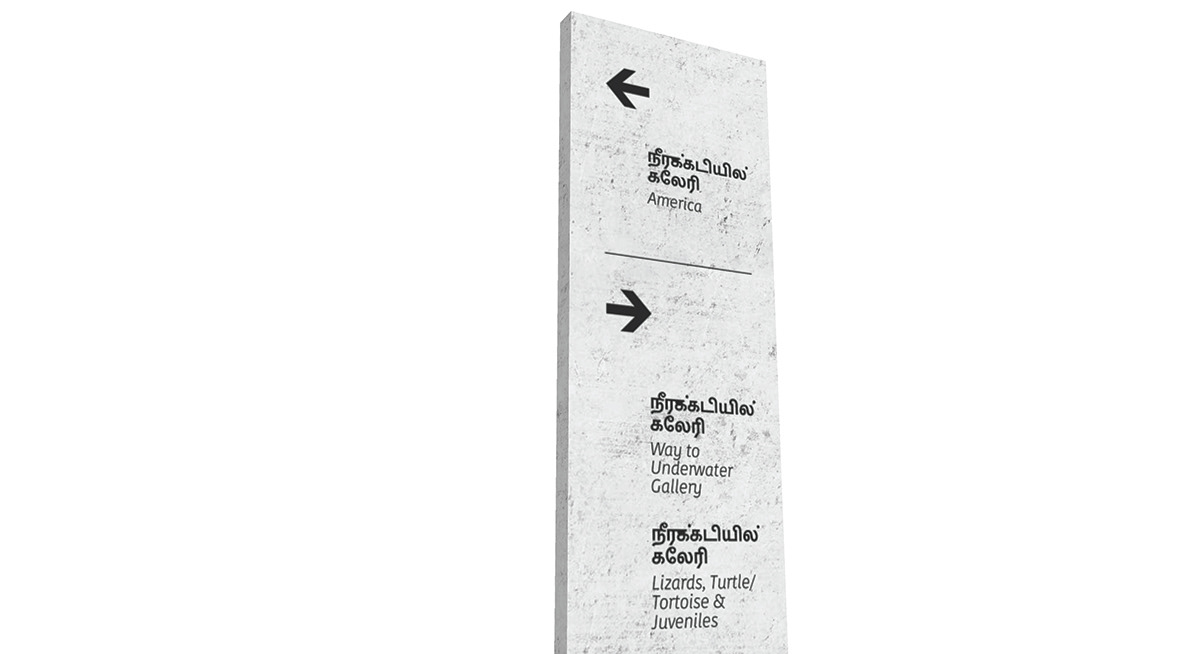Studio: Alva Architects
Project Head: Ashwin Alva
Architects: Nishant Gautam, Hiten Juneja
Exhibition & Spatial Designer: Nikhil Shrestha
Exhibition & Spatial Designer: Nikhil Shrestha
Client: Madras Crocodile Bank Trust (MCBT)
Project Brief
To upgrade the present facility to a world-class reptile park and endangered species captive - breeding center for education, conservation, and research, by developing a new masterplan.
Scope of Work
To design the visitor experience of the Madras Crocodile Bank focusing on spatial planning and the signage system.
This would also include me being a part of the architectural team, working on the overall design and conceptualization of the spaces, keeping in mind the safety of the visitors and the safety and well-being of the animals.
Foreword:
Bringing up the topic of zoos typically splits a room in two, sparking a debate about whether they should exist or not.
In my experience at a zoo in Thailand a few years ago, I saw a not so majestic polar bear repetitively taking a dip in the pool and panting heavily due to the extremely hot climate, not to mention the poor housing conditions; surrounded by blue and white painted concrete painted that cheaply imitated icebergs. Naturally, this made me have a negative impression on zoos thereafter.
For my graduation project, I decided that I wanted to try to address this and improve the habitats of zoo animals and on getting the opportunity for the project, I was very intrigued but also a bit unsure.
Deeply immersing myself in the research phase to get a holistic understanding of zoos in an unbiased manner helped me formulate my stance on them. Though my initial aim was to improve the animal's habitat, I realised that in order to add value to zoos, they needed to improve holistically which of course included the animal's habitats, but also the visitors, the staff, and other aspects related to zoos, which I hadn't considered earlier.
For my graduation project, I decided that I wanted to try to address this and improve the habitats of zoo animals and on getting the opportunity for the project, I was very intrigued but also a bit unsure.
Deeply immersing myself in the research phase to get a holistic understanding of zoos in an unbiased manner helped me formulate my stance on them. Though my initial aim was to improve the animal's habitat, I realised that in order to add value to zoos, they needed to improve holistically which of course included the animal's habitats, but also the visitors, the staff, and other aspects related to zoos, which I hadn't considered earlier.
It is important to understand that all zoos can't be placed in the same box. They are a spectrum which includes everything from a roadside menagerie to a state of the art zoo which allows animals to live as natural a life as possible. There are 'good zoos', 'bad zoos' and everything in between, all of which have scope to improve drastically and serve a greater purpose. The zoos that exist for entertainment shouldn't exist in my opinion while zoos that educate people correctly, are active in conservation methods and research are zoos that can be justified.
Agreed, it is not ideal to keep animals away from their natural habitats, but due to human interference, more species have come under threat in the 20th century than ever before.
Our ecosystems are being ravaged by human activities - whether it’s the plastic pollution in our oceans and water bodies, the pollutant-filled air around us or the use of natural resources in a manner that isn’t sustainable.
Scientists predict that Earth’s sixth mass extinction event is already underway, termed the ‘Holocene extinction’ caused by humans. Plants and animals are dying out at a rate of 1000 to 10,000 times faster than before, with dozens of species going extinct every day.
Our ecosystems are now under serious threat, with most species believed to be going extinct within the next 50-100 years if nothing is done to save them. Overpopulation, overconsumption, habitat destruction, poaching, pollution, invasion by invasive species & climate change are all factors that threaten not just animal, but human life as well.
Making simple & conscious decisions in our daily lives could help improve the situation greatly - avoiding using plastic, being mindful of what you throw away, consuming consciously.
Our ecosystems are being ravaged by human activities - whether it’s the plastic pollution in our oceans and water bodies, the pollutant-filled air around us or the use of natural resources in a manner that isn’t sustainable.
Scientists predict that Earth’s sixth mass extinction event is already underway, termed the ‘Holocene extinction’ caused by humans. Plants and animals are dying out at a rate of 1000 to 10,000 times faster than before, with dozens of species going extinct every day.
Our ecosystems are now under serious threat, with most species believed to be going extinct within the next 50-100 years if nothing is done to save them. Overpopulation, overconsumption, habitat destruction, poaching, pollution, invasion by invasive species & climate change are all factors that threaten not just animal, but human life as well.
Making simple & conscious decisions in our daily lives could help improve the situation greatly - avoiding using plastic, being mindful of what you throw away, consuming consciously.
We are responsible for the future of these species, and the future of our planet.
Synopsis
After being open for 42 years, the Madras Crocodile Bank came to a decision that it needed urgent upgradation, as it had the potential to become a world-class reptile park for public visitation, as well as a centre for education, conservation and research. For this to happen, everything from water quality to the reptile exhibits and protocols needed to be examined, planned and revamped. To accomplish their goals, a masterplan would be developed which would be used as a basis for raising the necessary funds.
The role I played in this, was to develop the visitor experience of the new masterplan for the Madras Crocodile Bank, focusing on two aspects of the visitor experience - spatial planning and the signage system; This was done under the guidance and sponsorship of Alva Architects, based in New Delhi.
Data collection included research and collation of case studies through online resources, documentation provided by the client, referencing publications, scientific publishings, guidelines and standards, conference papers, articles and blogs on zoo design, visitor experience as well as the on animals.
An in-depth analysis of the proposed architectural plans was carried out to get a thorough understanding. This was done to understand the movement of people on the proposed plan, check for bottlenecks and place the signage at apporpriate locations.
Empathy was a key factor that motivated me throughout the project. Viewing things at par with the visitors, the staff and of course with the animals, brought in a multiple aspects to consider while making any decisions, big or small. While allocating enclosures to the animals, I used the knowledge gained from my research on the animals to draw meaningful connections between that and the visitor's interpretation of the same. I also addressed the visitor’s needs while developing the signage system, always checking on adding value to a sign, making them want to know more about the animals or trying to make it easier to interpret the conservation status that they would see on every animal identification board.
I concluded that a good zoo is one that keeps it's animals’ welfare as it's top priority, supported by good and ethical management practices, while also educating visitors, so that they gain a sense of empathy and understanding towards animals that carries on into their daily lives. If we remove the visitor from the equation, the zoo would be redundant, as there would be no way for a human to feel close to animals and see them in real life as the majestic living creatures that they are, rather than some image off the internet.
Although I didn't get the opportunity to work directly with the animal's habitats, doing in-depth research surfaced possibilities for positive design interventions in the context of zoos and has given me a strong base to build on.






















https://issuu.com/nikhilshrestha/docs/graduation_project_final_print_full






